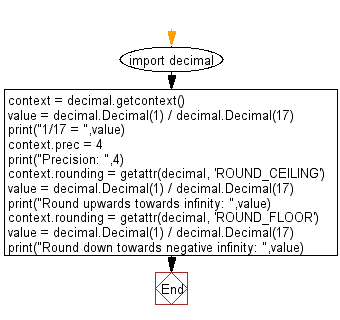Python Math: Round a specified number upwards towards infinity and down towards negative infinity
Python Math: Exercise-41 with Solution
Write a Python program to round a specified number upwards towards infinity and down towards negative infinity of precision 4.
Sample Solution:-
Python Code:
import decimal
context = decimal.getcontext()
value = decimal.Decimal(1) / decimal.Decimal(17)
print("1/17 = ",value)
context.prec = 4
print("Precision: ",4)
context.rounding = getattr(decimal, 'ROUND_CEILING')
value = decimal.Decimal(1) / decimal.Decimal(17)
print("Round upwards towards infinity: ",value)
context.rounding = getattr(decimal, 'ROUND_FLOOR')
value = decimal.Decimal(1) / decimal.Decimal(17)
print("Round down towards negative infinity: ",value)
Sample Output:
1/17 = 0.05882352941176470588235294118 Precision: 4 Round upwards towards infinity: 0.05883 Round down towards negative infinity: 0.05882
Flowchart:

Python Code Editor:
Have another way to solve this solution? Contribute your code (and comments) through Disqus.
Previous: Write a Python program to round a specified decimal by setting precision (between 1 and 4).
Next: Write a Python program to get the local and default precision.
What is the difficulty level of this exercise?
Test your Programming skills with w3resource's quiz.
Python: Tips of the Day
Find current directory and file's directory:
To get the full path to the directory a Python file is contained in, write this in that file:
import os dir_path = os.path.dirname(os.path.realpath(__file__))
(Note that the incantation above won't work if you've already used os.chdir() to change your current working directory, since the value of the __file__ constant is relative to the current working directory and is not changed by an os.chdir() call.)
To get the current working directory use
import os cwd = os.getcwd()
Documentation references for the modules, constants and functions used above:
- The os and os.path modules.
- The __file__ constant
- os.path.realpath(path) (returns "the canonical path of the specified filename, eliminating any symbolic links encountered in the path")
- os.path.dirname(path) (returns "the directory name of pathname path")
- os.getcwd() (returns "a string representing the current working directory")
- os.chdir(path) ("change the current working directory to path")
Ref: https://bit.ly/3fy0R6m
- New Content published on w3resource:
- HTML-CSS Practical: Exercises, Practice, Solution
- Java Regular Expression: Exercises, Practice, Solution
- Scala Programming Exercises, Practice, Solution
- Python Itertools exercises
- Python Numpy exercises
- Python GeoPy Package exercises
- Python Pandas exercises
- Python nltk exercises
- Python BeautifulSoup exercises
- Form Template
- Composer - PHP Package Manager
- PHPUnit - PHP Testing
- Laravel - PHP Framework
- Angular - JavaScript Framework
- Vue - JavaScript Framework
- Jest - JavaScript Testing Framework
